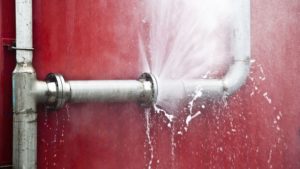YOUR TRUSTED LEAK DETECTION EXPERTS!
Complete Plumbing Heating and Air have been helping Orange County residents with plumbing pipe leaks for over 30 years. To properly diagnose the leaking copper, galvanized steel and PEX piping a company must have state of the art electronic leak detection to pinpoint the exact location of the plumbing leak.
Our trained technicians have years of plumbing pipe leak experience so we don’t waste your money and more importantly your valuable time. We will walk you through the necessary steps involved to expediently and economically resolve the issue.
Some common causes of water piping leaks
- High water pressure- California plumbing code mandates: in-home water pressure must be below 80 psi (pounds per square inch). Pressures exceeding 80 psi MUST have a pressure reducing / regulator valve installed on the main water line for home.
- Water treatment using Chloramines to fight bacteria. Check your annual water report to see if your city utilizes this type of treatment
- Electrolysis- when piping is connected to a dis-similar metal composition, corrosion and deterioration will occur even when dielectric unions and coupling are utilized. Water simply jumps across the fitting and attacks the weaker metal causing pinhole water leaks.
- Improper piping installation: When copper piping is initially installed a pipe cutter is used which utilizes a wheel to cut the pipe. The wheel produces a ridge on the inside of the pipe that causes the water to swirl and prematurely wear out the pipe or fitting causing pinhole water leaks. The pipe must be reamed with a special tool to prevent this from occurring. Unfortunately, some new construction plumbers, as well as re-piping companies, have to move very fast, to satisfy completion times, that this step gets missed more often than expected.
- When materials are delivered or have been sitting on a job site waiting to be installed, they can get dented or kinked which over time can develop a leak.
- When copper pipes are soldered an acidic paste called flux is used to flow the solder when the heat is applied. Leftover flux residue will cause leaks by eating holes in the copper pipe. This is evidenced by a green residue on the outside of the pipe.
- Hard water build-up becomes abrasive and can cause leaks. California water is very hard because of the minerals it picks up along the way.

What is a Slab Leak?
More than likely the copper pipes that supply water to the fixtures in your are installed under the concrete floor (referred to as a slab) they then penetrate the concrete inside the walls to make the pipe joint connections, from there they supply water to the various fixtures as well as the hose faucets outside. Problems can arise when the copper pipe develops a hole and leaks under the concrete, this can go undetected because of the plastic moisture barrier between the dirt and concrete. Left unattended these leaks may cause structural damage to the foundation from erosion.
SIGNS YOU MAY HAVE A PLUMBING LEAK
- A hot spot on the concrete slab floor- this is a strong indicator that you not only have a slab leak, but it is on the hot water side of the plumbing system. You can minimize damage from a hot water slab leak by turning off the valve at the top of the water heater.
- White powder residue on concrete, stains on the ceiling or wood flooring
- Higher than normal water bills
- Black mold or mildew appearing
- Hissing or dripping noises from underfloor, ceiling or walls
- Moist or wet spots
- Higher than usual water bills
- Higher than usual natural gas bills
- The water heater is running all the time
WHAT SHOULD YOU DO IF YOU SUSPECT A LEAK?
- Know where your main water shut off is located- usually at the front of the house by the hose faucet, exercise the valve bi-annually by simply turning it on and off several times to make sure it moves easily.
- Know where your water heater shut off valve is located- right-hand side on top of the water heater, exercise the valve bi-annually by simply turning it on and off several times to make sure it moves easily.
- Make sure you have no water running from fixtures or leaking toilets then take a picture of the water meter, revisit the water meter in 30 minutes and check to see if the needle or dial has moved.
